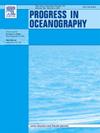Lifting the lid on Marine Heatwaves
IF 3.6
3区 地球科学
Q1 OCEANOGRAPHY
引用次数: 0
Abstract
Life is ubiquitous throughout the ocean, with species abundance and richness often greatest below the surface. As a result, ocean extremes throughout the water column may impact resident marine organisms and ecosystems. However, ocean extremes, such as marine heatwaves, have been commonly described based on surface observations. Given the importance of subsurface ocean processes, such as nutrient recycling, (de)oxygenation, and carbon transport, there has been an increasing focus on subsurface marine heatwaves (MHWs). Subsurface MHWs are prolonged warm ocean temperature extremes, and have a diversity of vertical structures linked with different driving mechanisms. Warming may be confined to the surface mixed layer; it may extend much deeper, potentially affecting the entire water column; it may appear only below the surface, with no surface signature, or it may be isolated near to or connected with the seafloor. Based on existing literature and a new analysis of subsurface MHW structure, we propose a comprehensive naming convention, differentiating between mixed layer, deep, thermocline, full depth, submerged and benthic marine heatwaves. Most surface-confined MHWs are associated with surface heat fluxes or shallow ocean advection or mixing. Conversely, many subsurface events are likely related to the vertical or horizontal displacement of temperature gradients/fronts, deep advection, and/or subduction of warm waters below the mixed layer. Different MHW vertical structures also have varying impacts on ocean biogeochemistry. However, due to the sparsity of physical, biogeochemical and biological observations, as well as the complexity of identifying and describing subsurface MHWs, there is limited understanding of the impact of subsurface MHW extremes. The nomenclature proposed in this paper seeks to provide a common language for understanding subsurface MHWs, thus enabling inter-disciplinary studies to quantify their impact.
揭开海洋热浪的盖子
生命在整个海洋中无处不在,物种的丰富性和丰富性往往在海面以下最大。因此,整个水柱的极端海洋现象可能会影响海洋生物和生态系统。然而,海洋极端现象,如海洋热浪,通常是基于地面观测来描述的。鉴于地下海洋过程的重要性,如养分循环、(脱)氧和碳运输,人们越来越关注地下海洋热浪(MHWs)。地下强震是长时间的暖海洋极端温度,具有多种垂直结构,与不同的驱动机制相联系。增温可能局限于地表混合层;它可能会延伸到更深的地方,潜在地影响整个水柱;它可能只出现在地表以下,没有地表特征,或者它可能被隔离在海底附近或与海底相连。在现有文献的基础上,结合对海底热浪结构的新分析,提出了一种综合命名规范,区分混合层、深层、温跃层、全深度、水下和底栖海洋热浪。大多数受地表限制的强震与地表热通量或浅海平流或混合有关。相反,许多地下事件可能与温度梯度/锋面的垂直或水平位移、深平流和/或混合层下暖水的俯冲有关。不同的MHW垂直结构对海洋生物地球化学也有不同的影响。然而,由于物理、生物地球化学和生物观测的稀缺性,以及识别和描述地下高温天气的复杂性,人们对地下高温天气极端事件的影响了解有限。本文提出的命名法旨在为理解地下mhw提供一种通用语言,从而使跨学科研究能够量化其影响。
本文章由计算机程序翻译,如有差异,请以英文原文为准。
求助全文
约1分钟内获得全文
求助全文
来源期刊

Progress in Oceanography
地学-海洋学
CiteScore
7.20
自引率
4.90%
发文量
138
审稿时长
3 months
期刊介绍:
Progress in Oceanography publishes the longer, more comprehensive papers that most oceanographers feel are necessary, on occasion, to do justice to their work. Contributions are generally either a review of an aspect of oceanography or a treatise on an expanding oceanographic subject. The articles cover the entire spectrum of disciplines within the science of oceanography. Occasionally volumes are devoted to collections of papers and conference proceedings of exceptional interest. Essential reading for all oceanographers.
 求助内容:
求助内容: 应助结果提醒方式:
应助结果提醒方式:


